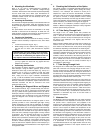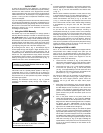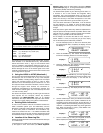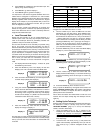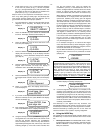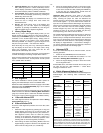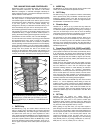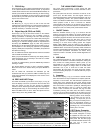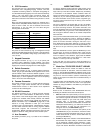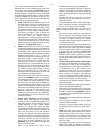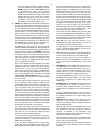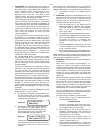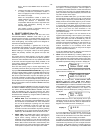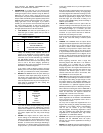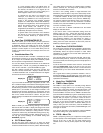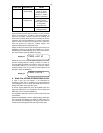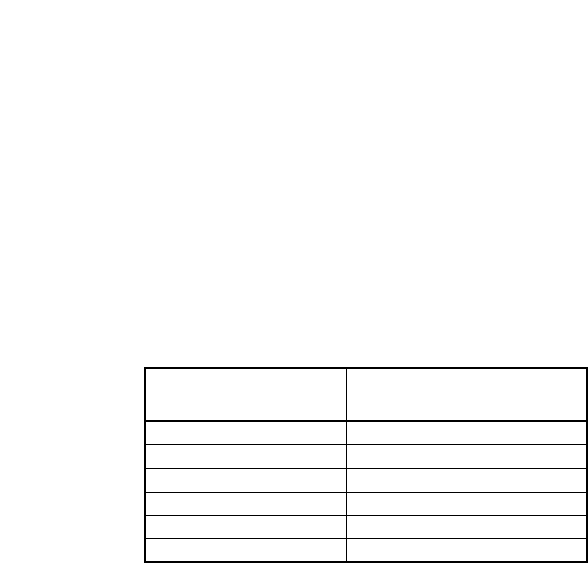
- 16 -
5. CCD Connector
The CCD Port (10, Fig. 7) allows direct interface from popular
aftermarket CCD autoguiding/imaging cameras with their
compatible connecting cables to accomplish autoguiding for
non-attended astrophotography. The CCD cameras effectively
watch a star and detect slight movements. When star
movements are detected, signals from the CCD electronics
make drive corrections in the LX200, to bring the star to a home
position.
Most CCD autoguiding/imaging cameras are supplied with a
cable which is compatible with the LX200 port. If your CCD unit
does not have a cable, one can be obtained from the CCD
manufacturer, or you can make your own cable using the
following table of information.
CCD LX200
Connector Pin Assignment
#1 Normally Closed
#2 West
#3 North
#4 Ground
#5 South
#6 East
6. Power 12 vDC Connector
The power 12 vDC connector (9, Fig. 7) is designed to accept
either the standard-equipment AC Converter or the optional DC
Power Cord. The acceptable voltage range (under load) is from
12 to 18 volts.
7. Keypad Connector
The keypad connector (6, Fig. 7) is a 4 pin phone jack
connector socket, designed to accept standard 4 pin phone
jack coil cords. One end of the supplied coil cord plugs into the
keypad port, the other end plugs into the LX200 keypad.
8. Reticle Connector
The Reticle connector (5, Fig. 7) accepts optional accessory
corded, plug-in style illuminated reticle eyepieces such as the
optional Meade 12mm Illuminated Reticle Eyepiece, or the
Meade Series 4000 Plössl 9mm Illuminated Reticle Eyepiece
(corded style), to allow brightness control and on/off pulsing
rates to be set from the LX200 keypad.
9. Focuser Connector
The focuser connector (4, Fig. 7) accepts optional accessory
corded, plug in style electric focusers such as the Meade
#1206 Electric Focuser, to allow electric focus adjustment
control from the LX200 keypad.
10. RS-232 Connector
The RS-232 connector (2, Fig. 7) allows personal computer
interface to allow communications at 9600 baud to access
every feature of the LX200 keypad. Many popular astronomy
programs are available which directly interface with Meade
LX200 telescopes, including Epoch 2000sk Sky Software by
Meade Instruments Corp. In
APPENDIX F
(page 58) of this
manual is a wiring schematic to make your own RS-232
connector cord, a cord test program, a demonstration program,
and the LX200 Command Set for writing programs. Meade
Instruments supplies this information for professional
programmers. Meade Instruments Corporation does not offer
support or advice for writing software for the RS-232 option.
11. Aux Connector
The Auxiliary connector (3, Fig. 7) is used for the 7" Maksutov
fan power.
MODE FUNCTIONS
To view the separate modes within the LX200 system, press
the MODE button located between the ENTER and GO TO
keys at the top of the hand controller. Simple entry and editing
of information in the different modes contained within the
system, will customize the operation of your LX200 to perform
virtually any of your observing requirements. Better still, all of
the critical information such as time, location, alignment type,
and many other functions are kept in memory...even with the
LX200 turned off!
The type of alignment, the objects that you see, the location
that you observe from, the tracking speeds of the drives, all of
the clock and timing functions, the position information, and
even the brightness level of the backlit keypad are defined by
the information that you give and/ or the commands that you
edit, through five different modes of the LX200 computerized
hand controller.
Once you have selected the desired mode, you can then select
the individual file within the mode by pressing the PREV or
NEXT key (up and down arrow key) in the bottom right hand
portion of the hand controller, moving the LCD arrow up or
down beside the file description. Although you will only be able
to see two menu selections at a time in the keypad display, you
will see more as you continue to press the PREV and NEXT
keys.
When the desired file is chosen, press the ENTER key to view
the files menu. To choose an individual menu, again use the
PREV or NEXT key to run the LCD arrow up or down the files
menu. To explore a menu selection, again press the ENTER
key. In some modes there will be options for a files menu
selection, in others you will only enter data.
At any time that you wish to return to main file heading in a
particular mode, just press MODE and it will behave as an exit
key.
1. Mode One:
TELESCOPE/ OBJECT LIBRARY
This is the mode that the LX200 will default to after the
instrument completes its self-check, when the LX200 is first
turned on. The TELESCOPE/OBJECT LIBRARY mode can be
thought of as command central. It is here that we can select the
way that we want the LX200 to perform mechanically, and
where we can explore and select from its extensive library of
stored objects.
To explore either the TELESCOPE menu file or the OBJECT
LIBRARY menu file, move the LCD arrow to the appropriate
selection by using the PREV or the NEXT key and press the
ENTER key.
a. TELESCOPE Menu File
Below are the 14 selections of the TELESCOPE menu file,
illustrating the individual menu files and file options.
1. SITE:The SITE menu option allows you to enter up to four
of your favorite viewing locations in longitude and latitude.
The entered longitude and latitude is compared by the
LX200’s computer to your local time, GMT offset, and
calendar date to accurately calculate celestial
coordinates. Once entered, the information is stored in the
telescope’s internal memory, you need never re-enter the
same information. To enter new site information or to
change an old one, see
QUICK START
, page 9.
You can choose any one of the four site options (or the
UNKNOWN site) at your convenience, without the bother
of entering longitude and latitude every time you use the
LX200. Once the site is chosen, exit the SITE menu by
pressing the MODE key.
2. ALIGN: The Align menu selection of the TELESCOPE file
demonstrates the unique ability to transform the LX200
into an Altazimuth, celestial tracking telescope, a polar-
equatorial celestial tracking telescope, or land spotting
scope with electric Altazimuth movements within three



